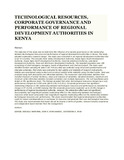Please use this identifier to cite or link to this item:
http://ir-library.mmust.ac.ke:8080/xmlui/handle/123456789/1898Full metadata record
| DC Field | Value | Language |
|---|---|---|
| dc.contributor.author | WANYAMA, EZEKIEL WECHULI | - |
| dc.contributor.author | BYARUHANGA, JOHN K. | - |
| dc.contributor.author | SHITSESWA E, AYUB | - |
| dc.date.accessioned | 2021-12-20T05:20:06Z | - |
| dc.date.available | 2021-12-20T05:20:06Z | - |
| dc.date.issued | 2020-07 | - |
| dc.identifier.uri | http://strategicjournals.com/index.php/journal/article/view/1655 | - |
| dc.identifier.uri | http://ir-library.mmust.ac.ke:8080/xmlui/handle/123456789/1898 | - |
| dc.description.abstract | The objective of this study was to determine the influence of corporate governance on the relationship between technological resources and performance of regional development authorities in Kenya. The study adopted explanatory research design. The study was conducted in six regional development authorities that cover 47 counties. This includes Kerio Valley Development Authority, Ewaso Ngiro South Development Authority, Ewaso Ngiro North Development Authority, Coast Development Authority, Lake Basin Development Authority, Tana and Athi Rivers Development Authority. The targeted population was 169 comprising of chief managers, managers, heads of department and chief accountant. The study used stratified random sampling to select 118. Primary data was collected using structured questionnaires and interview schedules. Pilot study was conducted to test validity and reliability of research instruments. Validity was ascertained using content and construct validity while reliability using Cronbach alpha. Data was analyzed using both descriptive and inferential statistics. The researcher used descriptive statistics that included measure of central tendency; mean and measure of variability; standard deviation, maximum and minimum while inferential statistics included correlation and multiple regressions. The null hypotheses were tested at 5% significance level. The findings revealed that when technological resources changes by a unit, performance changes by 0.236 units (β2=0.236, P=0.011). Corporate governance has significant moderating influence on the relationship between technological resources and performance as indicated by change in R2=0.254, p=0.000 implying that the corporate governance explained up to 25.4% change in performance of regional development authority. However, the interaction effect was not significant. Accountability had insignificant positive moderating effect on the relationship between technological resources while board composition had insignificant negative moderating effect on the relationship between technological resources and performance. The study recommended that regional development authorities ought to reduce overdependence on exchequer to resources but generate their own technological resources. The study also recommended that board should be diverse in terms of gender, relevant industry experience and independent board member from the management. | en_US |
| dc.language.iso | en | en_US |
| dc.publisher | Strategic Journal of Business & Change Management | en_US |
| dc.subject | TECHNOLOGICAL, RESOURCES, CORPORATE, GOVERNANCE , PERFORMANCE, REGIONAL, DEVELOPMENT, AUTHORITIES | en_US |
| dc.title | TECHNOLOGICAL RESOURCES, CORPORATE GOVERNANCE AND PERFORMANCE OF REGIONAL DEVELOPMENT AUTHORITIES IN KENYA | en_US |
| dc.type | Article | en_US |
| Appears in Collections: | Journal Articles | |
Files in This Item:
| File | Description | Size | Format | |
|---|---|---|---|---|
| TECHNOLOGICAL RESOURCES.pdf | 275.79 kB | Adobe PDF |  View/Open |
Items in DSpace are protected by copyright, with all rights reserved, unless otherwise indicated.
